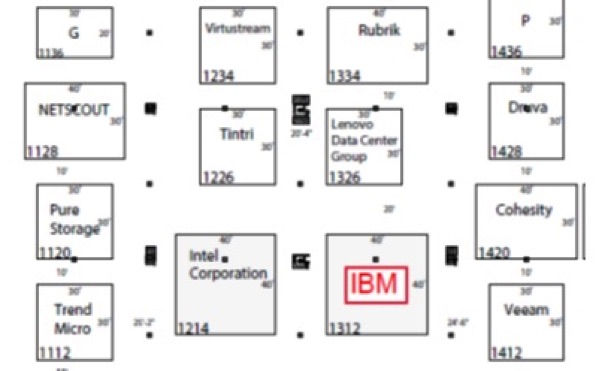Report on VMworld 2018 by Jerome Wendt, DCIG
Analytics, automation and hybrid clouds among key takeaways
This is a Press Release edited by StorageNewsletter.com on September 11, 2018 at 2:38 pm This article was published on September 6, 2018 and was written by Jerome M. Wendt, president and lead analyst of DCIG, Inc., an independent storage analyst and consulting firm.
This article was published on September 6, 2018 and was written by Jerome M. Wendt, president and lead analyst of DCIG, Inc., an independent storage analyst and consulting firm.
Analytics, Automation and Hybrid Clouds
among the Key Takeaways from VMworld 2018
At early VMworld shows, stories emerged of attendees scurrying from booth to booth on the exhibit floor looking for VM data protection and hardware solutions to address the early challenges that VMware ESXi presented.
Fast forward to the 2018 VMworld show (August 26-30, Las Vegas, NV) and the motivation behind attendees attending training sessions and visiting vendor booths has changed. Now they want solutions that bring together their private and public clouds, offer better ways to analyze and automate their virtualized environments, and deliver demonstrable cost savings and/or revenue opportunities after deploying them.
The entrance to the VMworld 2018 exhibit hall greeted attendees a little differently this than in year’s past. Granted, there were still some of the usual suspects such as Dell EMC and HPE that have reserved booths at this show for many years. But right alongside them were relative newcomers (to the VMworld show anyway) such as Amazon Web Services and OVHcloud.
Click to enlarge
 Then as one traversed the exhibit hall floor and visited the booths of the vendors immediately behind them, the data protection and hardware themes of the early VMworld shows persisted in these booths, though the messaging and many of the vendor names have changed since the early days of this show.
Then as one traversed the exhibit hall floor and visited the booths of the vendors immediately behind them, the data protection and hardware themes of the early VMworld shows persisted in these booths, though the messaging and many of the vendor names have changed since the early days of this show.
Click to enlarge
Companies such as Cohesity, Druva, and Rubrik represent the next generation of data protection solutions for vSphere while companies such as Intel and Trend Micro have a more pronounced presence on the VMworld show floor. Together these exhibitors reflect the changing dynamics of what is occurring in today’s data centers and what the current generation of organizations are looking for vendors to provide for their increasingly virtualized environments.
Consider:
1 Private and public cloud are coming together to become hybrid. The theme of hybrid clouds with applications that can span both public and private clouds began with VMworld’s opening keynote announcing the availability of Amazon Relational Database Service (Amazon RDS) on VMware. Available in the coming months, this functionality will free organizations to automate the setup of SQL Server, Oracle, PostgreSQL, MariaDB and MySQL databases in their traditional VMware environments and then migrate them to the AWS cloud. Those interested in trying out this new service can register here for a preview.
2 Analytics will pave the ways for increasing levels of automation. As organizations of all sizes adopt hybrid environments, the only way they can effectively manage their hybrid environments at scale is to automate their management. This begins with the use of analytics tools that capture the data points coming in from the underlying hardware, the OSs, the applications, the public clouds to which they attach, the databases, the devices which feed them the data, whatever.
Evidence of growing presence of these analytics tools that enable this automation was everywhere at VMworld. One good example is Runecast analyzes the logs of these environments and then also scours blogs, white papers, forums, and other online sources for best practices to advise companies on how to best configure their environments. Another one is Login VSI which does performance benchmarking and forecasting to anticipate how VDI patches and upgrades will impact the current infrastructure.
3 The cost savings and revenue opportunities for these hybrid environments promise to be staggering. One of the more compelling segments in one of the keynotes was the savings that many companies initially achieved deploying vSphere. Below is one graphic that appeared at the 8:23 mark in this video of the second day’s keynote where a company reduced its spend on utility charges by over $60,000 per month or an 84% reduction in cost. Granted, this example was for illustration purposes but it seemed inline with other stories I have anecdotally heard.
Click to enlarge
But as companies move into this hybrid world that combines private and public clouds, the value proposition changes. While companies may still see cost savings going forward, it is more likely that they will realize and achieve new opportunities that were simply not possible before. For instance, they may deliver automated disaster recoveries and HA for many more or all their applications. Alternatively, they will be able to bring new products and services to market much more quickly or perform analysis that simply could not have been done before because they have access to resources that were unavailable to them in a cost-effective or timely manner.















 Subscribe to our free daily newsletter
Subscribe to our free daily newsletter

